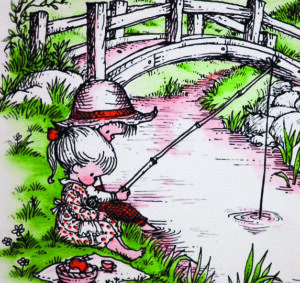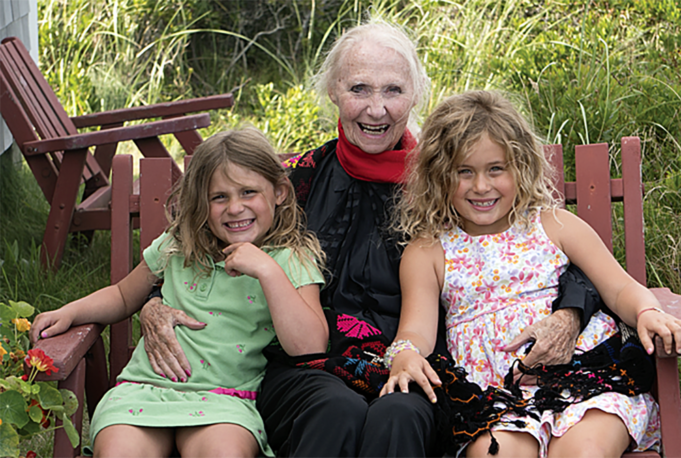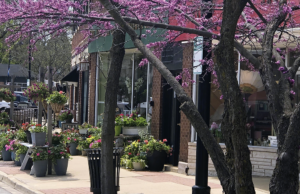The local area native who became a world-renowned children’s author
By Maureen Callahan
 What is a friend?
What is a friend?
The answer depends on who you ask. A friend is someone who helps you. It’s someone with whom you have shared memories and common ground. A friend- above all- is someone who likes you.
Joan Walsh Anglund, a former Downers Grove and Hinsdale resident, was the children’s author who illustrated this fundamental idea on paper in 1958. But the echoes of Anglund’s first book, A Friend is Someone Who Likes You, are still heard. Her work found its way to many corners of the earth- even through the wrought iron gates of Buckingham Palace and into the royal hands of noted fan, Queen Elizabeth II.
A Friend is Someone Who Likes You is the storybook that launched Anglund’s career as a children’s book author and illustrator. The idea for the simple yet profoundly themed story came shortly after her young family moved to New York City in the mid-1950s. Anglund and her children found themselves lonely after moving to the Big Apple. Longing for her Midwestern roots, she glanced out at the Manhattan skyline and imagined a potential friend behind every window.
She began to rethink her idea of friendship. “A friend can be a boy or a girl or a cat or a dog, or even a tree that lets you climb it easily,” Anglund once said. The overarching message to young readers is that sometimes, you have to find your friends. A Friend is Someone Who Like You was named one of the New York Times’s ten best-illustrated books of 1958. The book, still in print, has sold four million copies.
The story came alive through illustrations of her own children playing in nature. “My mother always carried a sketch pad with her,” said daughter Joy Anglund Harvey. “She was always drawing and writing little poetic phrases.”
Ironically, the sketches were based on a family farm- a now-developed plot of land on Plainfield Rd in south Downers Grove. “That farm is a huge part of my memory,” said Joy. “We spent every summer at the farm in Downers Grove.”
The book launched a wildly successful career that spanned half a century and produced over 120 titles. All touch on universal themes such as love, friendship, and holidays. Titles such as Look Out the Window (1962), What Color is Love (1966), and Spring is a New Beginning (1963), are works of Anglund’s collection that have sold 50 million copies in 17 languages.
Anglund came to be known for her iconic illustrations in which children have only eyes- no other facial features. “Children move too quickly,” she once offered by way of explanation for her distinct style. “I didn’t have time to draw their whole faces.”
For inspiration, she largely observed her children and grandchildren at play. “My mother came into our rooms and sketched the toys on the floor, our living room at Christmastime, my cat, the dresses and overalls we wore,” said Joy, fondly. Anglund often discreetly wove a child’s name into a scene. Anglund’s son, Todd- whom she lost at an early age- served as the muse for the title character, The Brave Cowboy (1959), and its sequels.
Born Joan May Walsh in Hinsdale in 1926, Anglund lived with her family in Downers Grove for the first decade of her life. The child of two artists, Anglund often drew in the attic of the family’s Prince Pond home. Her father, Thomas Walsh, was a commercial artist who drew one of the versions of the iconic Morton Salt girl. He frequently drew whimsical, illustrated messages for his family on the porcelain kitchen table before leaving for the day. He nurtured his daughter’s talent as he taught her drawing techniques.
Anglund attended kindergarten at Avery Coonley School, which had a profound impact on her. “My mother told wonderful stories, well into her nineties, of being outdoors and taking nature walks on the school’s wooded grounds,” said Joy. “It’s how she learned to love nature.”
The primary years were spent at St Joseph School. Anglund’s family lived on Saratoga, just blocks away. She and her sister bounced down the sidewalk to 6 a.m. mass every day, after which they sewed the altar cloths before school began. “My grandmother remembered the nuns who taught her as being strict, but she loved them,” said granddaughter Emily Anglund Nellen. “They instilled a strong faith in her, which grounded her life.”
The next few years were wrought with tragedy. Anglund’s younger sister died of spinal meningitis as a toddler. Her grandfather was killed in a train accident, and her father by a drunk driver shortly thereafter. With the Great Depression looming, Anglund’s mother packed her and her sister into the family car and drove to Florida. They stayed a year. “It was the best thing we could have done,” Anglund later told filmmaker Tim Jackson in a documentary about her life. “We were able to be outside in nature all the time. It helped us heal.”
A year later, the family moved back to the area. They settled in Hinsdale, with Anglund’s grandparents. She graduated from Hinsdale High School in 1944. She went on to attend The School of the Art Institute. As a student, she met her husband, Robert Anglund, a student at The Goodman Theater across the street. The two married a year later.
Anglund pursued her dreams as a commercial artist. Among other opportunities, she worked a stint for Marshall Field & Company. A few years later, the couple moved their family to New York and eventually Connecticut, where they built a life on the east coast.
She imparted her free-spirited nature to her family. “My children grew up in my art studio,” Anglund recounted. Not one to take time from her children during the day, she often worked through the night. Her career took an upward turn as she built a cottage industry as her characters appeared on Hallmark cards, dolls, bedsheets, and beach towels.
Her work closely followed a nature theme. She made her children’s childhood idyllic. “Getting outside into nature was a daily requirement,” said Joy. “Rain or shine, we went outside and always reported what we observed while building a snowman or jumping in leaves.” Anglund and her family spent 60 summers on Nantucket Island. “My mother loved the sea and that was a great place to be outdoors,” Joy remembered.
Despite her great success, the author led a quiet and humble life. She greeted a fan waiting for an autograph like they were the only person who ever asked. “My grandmother was always thrilled at the impact her work had on people,” said Emily. “Her goal was never to become famous; just to create her artwork.”
Anglund passed away in 2021 at the age of 95. “I don’t know why I was given such a good life,” she once said, smiling. Regardless of her age, her spirit was eternally that of a child. “I have no intention to be old and sensible,” Anglund said. “Because every day, the world is new to me.”
For a poignant look at the author’s life, check out Joan Walsh Anglund: Life in Story and Poem, a documentary by Tim Jackson. ■

Joan Walsh Anglund, courtesy of the Anglund Family.
















I wanted to comment on your articles on Joan Walsh Anglund and Timothy Christian School. Both articles were enjoyable, and informative. I have 9 grandchildren and I am always looking for childrens’ books to read to them. Maybe you might consider a weekly column for children. I am aware of Timothy Christian School and Elmhurst is lucky to have such a good superintendent!
Comments are closed.